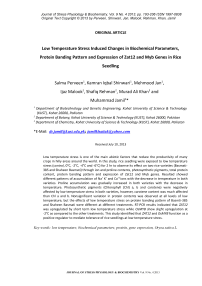Low temperature stress induced changes in biochemical parameters, protein banding pattern and expression of Zat12 and Myb genes in rice seedling
Автор: Perveen Salma, Shinwari Kamran Iqbal, Jan Mehmood, Malook Ijaz, Rehman Shafiq, Khan Murad Ali, Jamil Muhammad
Журнал: Журнал стресс-физиологии и биохимии @jspb
Статья в выпуске: 4 т.9, 2013 года.
Бесплатный доступ
Low temperature stress is one of the main abiotic factors that reduce the productivity of many crops in hilly areas around the world. In this study, rice seedling were exposed to low temperature stress (control, 0°C, -2°C, -4°C and -6°C) for 2 hr to observe its effect on two rice varieties (Basmati- 385 and Shaheen Basmati) through ion and proline contents, photosynthetic pigments, total protein content, protein banding pattern and expression of Zat12 and Myb genes. Resulted showed different patterns of accumulation of Na + K + and Ca +2 ions with the decrease in temperature in both varieties. Proline accumulation was gradually increased in both varieties with the decrease in temperature. Photosynthetic pigments (Chlorophyll (Chl) a, b and carotene) were negatively affected by low temperature stress in both varieties, however, carotene content was much affected than Chl a and b. Nonsignificant variation in protein contents was observed at all levels of low temperature, but the effects of low temperature stress on protein banding pattern of Basmti-385 and Shaheen Basmati were different at different treatments. RT-PCR results indicated that ZAT12 was upregulated by short term low temperature stress while OsMYB show slight upregulation at -2 oC as compared to the other treatments. This study identified that ZAT12 and OsMYB function as a positive regulator to mediate tolerance of rice seedlings at low temperature stress.
Low temperature, biochemical parameters, protein, gene expression, oryza sativa l
Короткий адрес: https://sciup.org/14323801
IDR: 14323801
Текст научной статьи Low temperature stress induced changes in biochemical parameters, protein banding pattern and expression of Zat12 and Myb genes in rice seedling
Both abiotic and biotic stresses severely affect the rice production in many parts of the world. Biotic factors include insect, pest and diseases while drought, temperature, salinity, cold, pollution and soil pH refer to abiotic stresses (Bashier et al., 2007; Oerke et al., 2001). Abiotic stresses severely effect production of crops by inducing a series of biochemical and molecular changes (Hasegawa et al., 2000).
Low temperature stress is one of the major abiotic factor that limit the agricultural productivity of crops in hilly areas. Plants respond and survive under stress conditions by bringing changes at the molecular and cellular levels as well as at the biochemical and physiological levels (Xin and Browse, 2000). Low temperature stress inhibits seedling establishment effecting early growth stages of rice and resulting in poor crop maturation. In order to gain stable rice production cold tolerance at the seedling stage is an important character. One of the most effective ways to avoid the low-temperature damage is to develop cold-tolerant genotype (Lou et al ., 2007; Law and Brandner, 2001). Mineral nutrition acquisition and assimilation are strongly influenced by both high and low temperature stress in plants (Rivero et al ., 2006). Some essential nutrients such as nitrogen (N), sulfur (S) phosphorus (P), magnesium (Mg), calcium (Ca) are structurally important for the proteins, nucleic acids, chlorophylls, certain secondary metabolites and defense related micro and macromolecules, while others have both structural and functional roles (Epstein and Bloom, 2005; Taiz and Zeiger, 2006).
Genes expressed under stress conditions may increase tolerance to growth retardation, cold, high salt concentration during normal conditions in rice transgenic and Arabidopsis (Dubouzet et al ., 2003; Ito et al ., 2006). It has been determined that in comparison with other cereals like wheat and barley, rice is more sensitive to cold stress (Wen et al ., 2002). Low temperature stress induces many genes, acting either as protectants towards stress-induced damage or regulates expression of other genes and transduce signal (Kang et al ., 2002; Yu et al ., 2002; Shinozaki et al ., 2003). Davletova et al .
-
(2011) investigated that in contrast to many signaling and regulatory genes that are stress specific, Zat12 which is a zinc-finger protein gives response to various abiotic and biotic stresses and plays an important role in abiotic stress signaling in Arabidopsis. Similarly, MYB transcription factors play a central role in plant growth and respond to stress conditions (Yang et al . 2011). OsMYB2 encodes a MYB transcription factor (stress-responsive element), which is involved in regulation of various pathways leading to tolerance of rice to dehydration stress, salt and cold.
Low temperature exposure often induces a variety of biochemical, physiological and enzymatic change in plant, which can result in an acclimation response (Howard and Ougham, 993; Hughes and Dunn, 1996). Rice is sensitive to chilling stress and its persistence leads to poor germination, stunted seedling, yellowing or withering and decreased tillering (Mukhopadhyay et al ., 2004). In this study, we had exposed the rice seedling to short duration low temperature to investigate its effect on ion contents, proline, photosynthetic pigments, total protein and nitrogen content, protein banding pattern and expression of Zat12 and Myb genes.
MATERIALS AND METHODS
Two varieties of rice, Shaheen Basmati and Basmati- 385 were obtained from the National Agriculture Research Center (NARC) Islamabad.
Seedling growth
Ten days old seedlings were transferred to plastic pots containing well washed sand and irrigated with Hoagland solution. After three weeks, the seedlings were subjected to low temperature stresses (control, 0°C, -2°C, -4°C and -6°C) for 2 hours in ultra low freezer and the fresh leaves of each replica were cut with sterile scissors and the pieces of leaves were divided into two parts. The plant material was used for the following tests.
-
a) Biochemical analysis
-
b) Molecular analysis
-
a) Biochemical analysis
Determination of Na+, K+ and Ca+2 ions
Dried plant material (25 mg) was digested with the help of H 2 SO 4 and H 2 O 2. The digested material was diluted with 20 ml of distilled water and filtered with the help of Whattman filter paper. Ionic concentrations were determined with the help of flame photometer (Model:Jenway PF5).
Proline analysis
Proline quantification was done following the protocol described by Bates et al. (1973) with a slight modification. Fresh plant material (100 mg) was crushed in liquid nitrogen and homogenized in 5 ml of 3% salfosalicylic acid. The homogenate (~1 ml) was mixed with 1 ml of acid ninhydrin for 1 hour at 100 °C in oven. The reaction mixture was vigorously mixed with 2 ml of toluene and placed at room temperature for 30 minutes. The optical density was measured spectrophotometrically at 520 nm using toluene as a blank.
Determination of Chlorophyll and Carotenoids
Lichtenthaler and Wellburn (1985) method was used for the determination of chlorophyll and carotenoids content. Dried plant sample (25 mg) was taken in a test tube. Equal amount of MgO (25 mg) was added to neutralize plant acid and prevent the formation of pheophytin. The turbid pigment extract was centrifuged for 5 minutes at 4000 rpm at room temperature. The absorbance reading was taken against a solvent blank in a (UV-VIS) spectrophotometer at three wavelengths: 666 nm, 653 nm and 470 nm. The chlorophyll “a”, “b” and carotenoids in methanol were calculated by the formulas suggested by Lichtenthaler and Wellburn (1985).
Determination of Total Protein Content
Protein content was determined by using the method of Pellett and Young (1980). Dried plant material (100 mg) was taken in a digestion flask containg 100 mg of digestion mixture (potassium sulphate, copper sulphate and iron sulphate) and 2 ml of conc. H 2 SO 4 . The digest was transferred to the distillation assembly and 10 ml of 50 % NaOH solution was added to the digestion mixture. The distillation was completed in 3 minutes with the change of color of boric acid to colorless. The boric acid having the trapped ammonia was titrated with 0.1N H 2 SO 4 . The color of boric acid having ammonia changed again into pink. Total protein content was calculated by using the formula’s recommended by Pellett and Young (1980).
-
b) Molecular analysis
Protein extraction
Proteins were analyzed by SDS-PAGE (Sodium dodecyl sulfate-Polyacrylamide Gel Electrophoresis) using the method described by Laemmli, (1970). The plant material (10 mg) was crushed in the presence of liquid nitrogen and homogenate it in 400 ul protein extraction buffer ((Tris-HCL 0.5 M (pH 8), 2.5% SDS, 10% Glycerol, 5% 2- merceaptoethanol). In order to purify the homogenate, samples were centrifuged at 13000 rpm for 10 minutes at room temperature. The supernatant was transferred to new 1.5 ml Eppendorf tubes and stored at 4°C until they were electrophoresised on the PAGE.
Electrophoresis was performed at 80 V for 2 and half hours by using Standard Twin Mini Gel Unit (USA). The gel was stained with Coomassie Brilliant Blue R-250 (Sigma) for 40 minutes and destained with 20% methanol, and 5% acetic acid. The molecular weight of protein subunits was compared with standard protein molecular weight marker bands (Benchmark Protein Ladder 10 – 220 KDa) in the electrophorogram.
PCR amplification of the desired genes
Plant leaves (140 mg) were crushed in liquid nitrogen. RNA was extracted by using Trizole reagent. cDNA was synthesized with MMLV reverse transcriptase enzyme by using Oligo (dT) primer After cDNA synthesis, the genes were amplified by gene/s-specific primers (Table 1). The following conditions of PCR were used: pre denaturation of 5 min at 95 oC; 45 cycles of 20 Sec at 95oC, 30 Sec at 60oC, 40 Sec at 72oC and a final extension for 15 min at 72oC. The amplified gene/s was separated on 1.5% agarose gel.
Statistical analysis
All the data were analyzed by using statistical software Statistix 9 for ANOVA, followed by least significant difference (LSD).
RESULTS
Biochemical parameters
Ions contents (K+, Na+ and Ca+2)
Results indicated different pattern of accumulation of Na+ K+ and Ca+2 ions with the decrease in temperature in both varieties (Fig. 1). In Basmati-385, K+ ion concentration was increased from control (40 ug/g) to -6°C (43.2 ug/g) (Fig. 1A), while in Shaheen Basmati, the concentration of K+ ion was maximum at -4°C (45.4 ug/g) under low temperature stress (Fig. 1B). For Na+ ions, Basmati-385 showed the lowest level (20.2 ug/g) at -6°C (Figure 1A). Shaheen Basmati also showed reduction in the Na+ ion concentration except at -6°C as compared to control (Fig. 1B). In Basmati-385, Ca+2 ion was gradually decreased except at 0°C.
In Shaheen Basmati, there was a steady increase in Ca+2 ion concentrations from -2°C (8.766 ug/g) to -6°C (15.55ug/g) with the decrease in temperature (Fig. 1B).
Proline content
The results of our study indicated that with the decrease in temperature, the proline accumulation was gradually increased in both varieties (Fig. 2 A, B). In Basmati-385, the maximum amount of proline was found at -6°C (0.65125 μg/g) as compared to control (0.2075 ug/g) (Fig. 2A). In Shaheen Basmati, the amount of proline was increased from control (0.29 ug/g) to -6°C (0.6915 μg/g) under low temperature stress (Fig. 2B).
Chlorophyll Contents
The concentrations of photosynthetic pigments were negatively affected by low temperature stress in both varieties (Fig. 3). In Basmati-385, chlorophyll ‘a’ content had a maximum value (5.731 ug/g) at -2°C and the lowest value (4.64 ug/g) was seen at -4°C (Fig. 3A). Chlorophyll ‘b’ content was also decreased under low temperature stress in Basmati-385, showing the lowest value (4.1 ug/g) at 0°C (Fig. 3A). Under low temperature stress, carotene content was gradually decreased from control (5.38 ug/g) to -6°C (1.1 ug/g) in Basmati-385 (Fig. 3A). In Shaheen Basmati, the chlorophyll ‘a’ content had the minimum value at 0°C (4.33 ug/g), while chlorophyll ‘b’ content was decreased from control (5.57 ug/g) to -6°C (4.0 ug/g) while carotene content showed minimum concentration at 0°C (3.8 ug/g) (Fig. 3. B).
Protein content
Nonsignificant variation in protein contents was observed at all levels of low temperature treatments in Basmati-385 (Fig. 4.). However in Shaheen Basmati, low temperature stress increased the protein content at -2°C as compared to control while the other treatments showed the same level of protein content as in control in Shaheen Basmati under low temperature stress (Fig. 4).
Molecular analysis
Protein analysis by SDS-PAGE
The effects of low temperature stress on protein profile on both varieties were different. Protein banding pattern of Basmti-385 and Shaheen Basmati was between 15kDa and 40kDa with reference to the marker. The banding intensity of different polypeptide bands (35, 30, 28, 20 and 15kDa) of Shaheen Basmati was higher than Basmati-385 under low temperature treatment. In Basmati-385, the intensity of these bands was much lower between 15 KDa and 30 KDa at -4 °C as compared to control, however at -6 °C bands between 15 KDa and 30 KDa showed high intensity than other low temperature treatments. In Shaheen Basmati under low temperature stress, there was an induction of the band at 35 KDa which was absent in Basmati-385. It has been observed that in Shaheen Basmati, the intensity of protein bands (35, 30, 28, 20 and 15kDa) was greater in treated plants as compared to untreated plants (Fig. 5).
Expression of Zat and Myb genes
Reverse transcription (RT)-PCR approach was used to find the expression of four stress inducible genes ( ZAT12-1, ZAT12-9, OsMYB2 and OsMYB6 ) in Basmati-385 and Shaheen Basmati (Fig. 6) There was a significant difference in gene expression between these two varieties.
In Basmati-385 the expression of ZAT12-9 was upregualted than ZAT12-1 under low temperature treatments. However, ZAT12-1 was slightly expressed at -2oC and -4oC, while there was no expression at -6oC. ZAT12-9 was highly expressed at 0oC, -2oC and -6oC, however no expression was observed at -4oC. In case of OsMYB2 and OsMYB6 both showed slight upregulation at -2oC as compared to the other treatments. In Shaheen Basmati, ZAT12 genes showed high upregulation than MYB genes under low temperature treatments. ZAT12-9 was strongly upregulated than ZAT12-1 , however ZAT12-9 was down regulated at -2oC as compared to other treatments. OsMYB2 showed high upregulation than OsMYB6 under low temperature stress. OsMYB2 showed slight expression at 0oC and -2oC and highly expressed at -6oC while OsMYB6 did not give any expression at control (Fig. 6).
Table 1. Sequences of forward and reverse primers used for amplification of cDNA
|
Genes |
Forward primers |
Reverse primers |
|
Actin |
5’- TGCTATCCCTCGTCTCGACCT-3’ |
5’-CGCACTTCATGATGGAGTTGTAT-3’ |
|
OsMYB2 |
5’-CGTGCTTGGATTGGTACGAG-3’ |
5’-TCAGGCTGTGGCACAGCCCG-3’ |
|
OsMYB6 |
5’-TCCAGCTTTCCAGTTCTTGG-3’ |
5’-GAAGGTGTAATCCATGGCCG-3’ |
|
ZAT12-1 |
5’-GATCGGCGACGTTAGTGAT-3’ |
5’-AAGGAAACAATCCAACATGG-3’ |
|
ZAT12-9 |
5’-GCTCGTCATTAAGAGCGAAA-3’ |
5’-TACAAGAAGGTTAAGTAACT-3’ |

Control О -2 -4 -6
Terne га tore (°C)
Figure 1. Effect of short term low temperature treatments on K+, Na+ and Ca+2 ions concentrations of Basmati-385 (A) and Shaheen Basmati (B). Vertical bars are the means of three replication±SD.
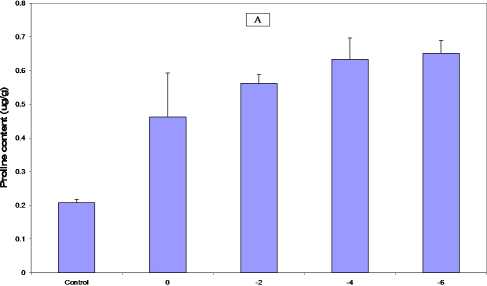
Temperature (°C)
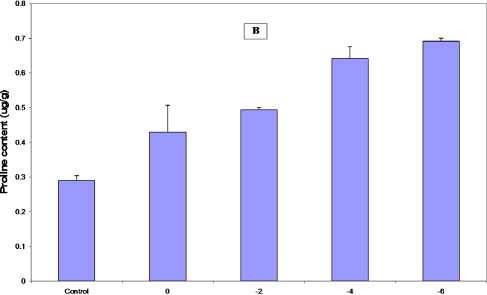
Temperature (°C)
Figure 2. Effect of short term low temperature treatments on proline content of Basmati-385 ( A ) and Shaheen Basmati ( B ). Vertical bars are the means of three replication±SD.
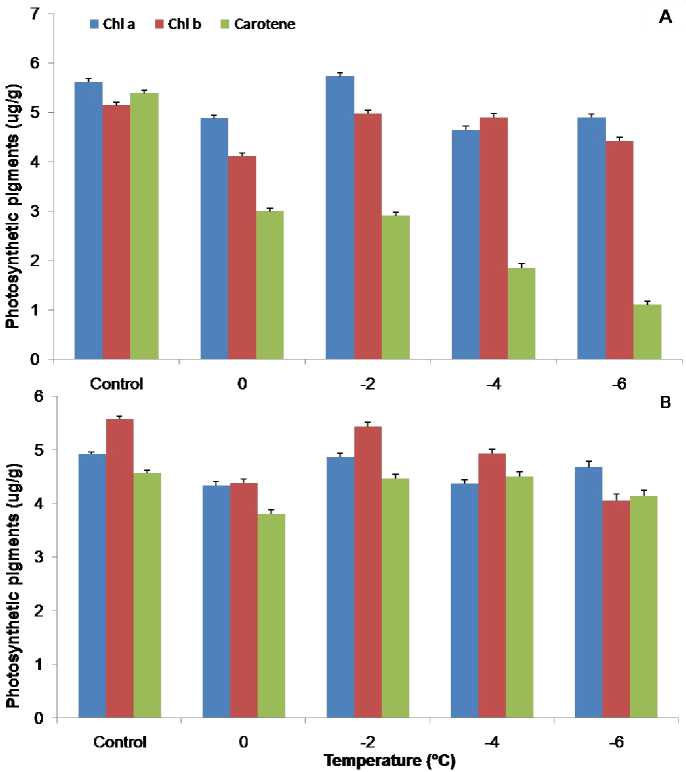
Figure 3. Effect of short term low temperature treatments on Chlorophyll “a, b and carotenoids” contents of Basmati-385 ( A ) and Shaheen Basmati ( B ). Vertical bars are the means of three replication±SD.
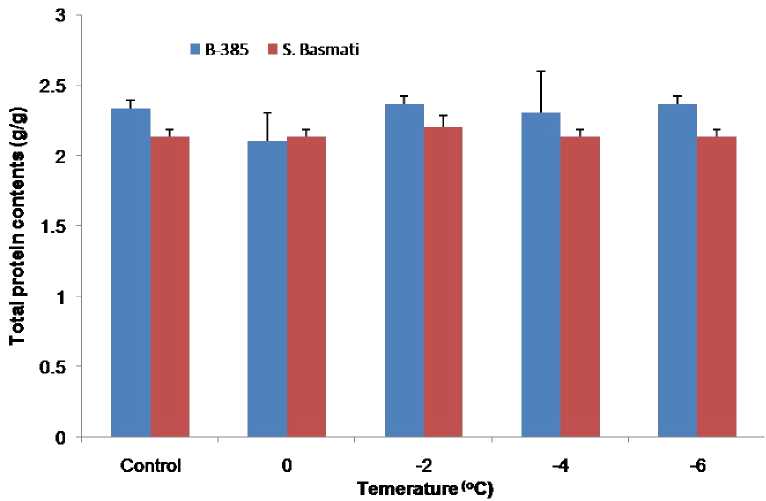
Figure 4. Effect of short term low temperature stress on total protein contents of Basmati-385and shaheen Basmati. Vertical bars are the means of three replication±SD.
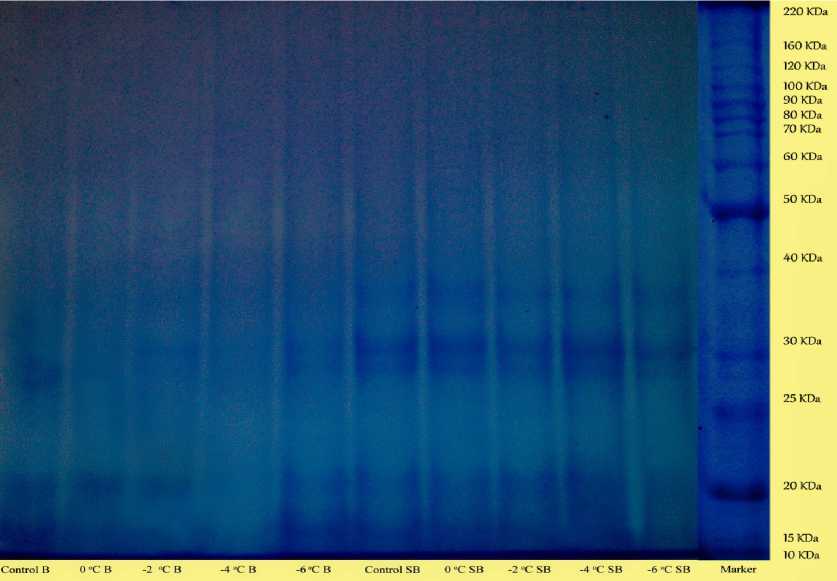
Figure 5. Effect of short term low temperature treatments on protein profile of Basmati-385 and
Shaheen Basmati. B represent Basmati-385 while SB for Shaheen Basmati.
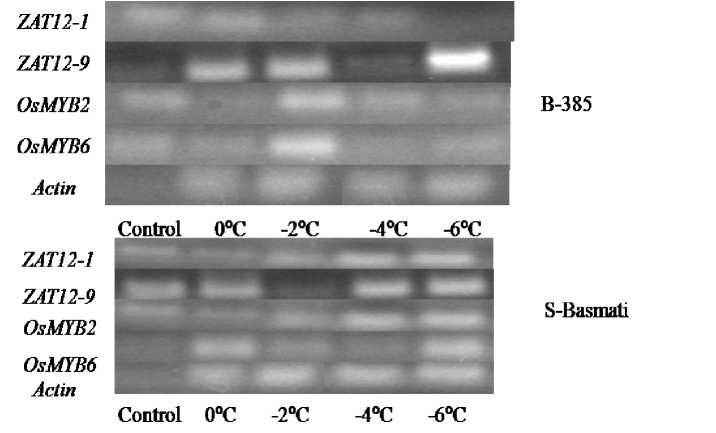
Figure 6. Gene expression of ZAT12-1, ZAT12-9, OsMYB2, OsMYB6 in Basmati-385 and Shaheen Basmati under short term low temp treatments.
DISCUSSION
It has been reported that mineral nutrition acquisition and assimilation is strongly influenced by both high and low temperature stress in plants (Taiz and Zeiger, 2006). Our study indicated that the accumulation of ions were different at different low temperature treatments. (Fig. 1). Reduction in Na+ ion helps the plant in the accumulation of other useful compounds. Tuteja and Sopory, (2008) investigated that Na+ ions maintain membrane potential and K+ ions keep osmotic balance and act as cofactor for many enzymes but under stress conditions their concentrations change significantly due to increase in electrical conductivity. In plants,
Ca+2 ions have role acting as important messengers under the low temperature signaling pathway. Komatsu et al . (2007) suggested that Ca2+ is increased by cold- stress treatment in the cytosol. Similarly in our study, we had observed that the overall Ca2+ content increased in both varieties (Fig. 1). According to Plieth et al . (1999), cold-induced Ca2+ influx in plants following a rapid temperature drop while Vergnolle et al . (2005) determined that calcium signal amplification might be involved in cold-stress signaling.
Proline is one of the main components of defense mechanism of the plant and its accumulation occurs in plant leaves towards abiotic stresses (Shamseddin-saeid and Farahbakhsh, 2008). It has been suggested that proline acts as a signal/regulatory compound which facilitates various physiological or molecular processes (Nowak et al ., 2010). Our study showed that proline accumulation increased by decreasing low temperature stress, which seems to be associated with adaptation to temperature stress (Fig. 2). Similar patterns of results were also found by Koc et al . (2010), they investigated that chilling effectively enhance the proline accumulation under chilling stress conditions. Proline has been shown to be one of the major factors impairing freezing tolerance (Habibi et al ., 2011).
Reduction of photosynthesis by low temperature is a well known response of chilling sensitive plants and it has been reported that chlorophyll ‘a’ and ‘b’ content decrease when plants are subjected to cold stress (Yadegari et al., 2007). In our results, slight decrease in photosynthetic pigments was observed under low temperature stress in both varieties as compared to their control values (Fig. 4). The possibility of low chlorophyll and carotenoid content could be oxidative stress caused by low temperature treatment (Yadegari et al., 2007). Our results have been confirmed by the research of Aghaee et al. (2011) that total chlorophyll concentration of rice leaves was reduced under cold treatment. Habibi et al. (2011) observed that the low temperature inducted significant decreases in the chlorophyll a and b content as a result of the total chlorophyll content of leaves.
In this study, we had observed the same level of protein content as compared to control all the treatments (Fig. 4). However, in Shaheen Basmati, low temperature caused an increase in proteins contents at -2°C as compared to control and other treatments (Fig. 4). Kazemitabar et al. (2003) subjected rice seedlings of different inbred lines to low temperatures for short periods i.e. for 6 hours at -2°C or -1°C. They found that changes in total leaf protein were detected but no clear difference was observed between susceptible and tolerant individuals. Lee et al. (2009) suggested that gene expression at the mRNA level of some selected proteins is not always concomitant to the translational level. Koc et al. (2010) investigated that synthesis of specific proteins is an important mechanism involved in increasing cold tolerance. As the present study indicated no significant increase in total protein content, therefore SDS page analysis was done to investigate the protein banding pattern. Protein banding patterns of Basmti-385 (Fig. 5) were between 30 kDa and 15 kDa with reference to the marker under low temperature stress. Different band positions between Shaheen Basmati and Basmati-385 indicated their specific response towards the given low temperature stress (Fig. 5) and also it reflects their different genetic variation. Kazemitabar et al. (2003) developed a method to expose rice seedlings of different inbred lines to low temperatures for short periods i.e. for 6 hours at -2°C or -1°C. The changes in total leaf protein were detected but no clear difference was observed.
It has been observed that genes expressed under stress conditions may increase tolerance to cold, high salt concentration during normal conditions in rice transgenic and Arabidopsis (Dubouzet et al ., 2003; Ito et al. , 2006). ZAT12 was unregulated in response to different low temperature stress (Iida et al ., 2000; Cheong et al ., 2002; Fowler and Thomashow, 2002; Kreps et al ., 2002; Rizhsky et al ., 2004; Davletova et al ., 2005). These findings were similar to our study that ZAT12 was upregulated by short term low temperature stress (Fig. 6). Recently it has been determined using transgenic plants that ZAT12 is involved in cold acclimation and in the response of plants to oxidative stress (Rizhsky et al ., 2004).
In case of Basmati-385, OsMYB2 and OsMYB6 both show slight upregulation at -2oC as compared to the other treatments while in Shaheen basmati, OsMYB2 showed more expression than OsMYB6 (Fig. 6). Yang et al . (2012) also found an increase in the OsMYB2 transcript when rice seedlings were exposed to low temperature (2°C). This study identified that ZAT12-1, ZAT12-9, OsMYB2, OsMYB6 function as a positive regulator to mediate tolerance of rice seedlings to low temperature stress. The up-regulation of these genes may allow rice plants to effectively osmo-regulate their water potential by accumulating compatible solutes and minimize oxidative damage to plants under low temperature stress.
ACKNOWLEDGEMENT
This study was financially supported by Higher Education Commission, Pakistan through research grants#1348.
Список литературы Low temperature stress induced changes in biochemical parameters, protein banding pattern and expression of Zat12 and Myb genes in rice seedling
- Aghaee, A., Moradi, F., Zare-Maivan, H., Zarinkamar, F., Irandoost, H.P. and Sharifi, P. (2011) Physiological responses of two rice (Oryza sativa L.) genotypes to chilling stress at seedling stage. African J. Biotechnol., 10, 7617-7621
- Bashier, K., Khan, N.M., Rasheed, S. and Salim, M. (2007) Indica rice varietal development in Pakistan: An overview. Paddy Water Environ., 5, 73-81
- Bates, L.S., Waldren, R.P. and Teare, I.D. (1973) Rapid determination of free proline for water studies. Plant Soil, 39, 205-208
- Cheong, Y.H., Chang, H.S., Gupta, R., Wang, X., Zhu, T. and Luan, S. (2002) Transcriptional profiling reveals novel interactions between wounding, pathogen, abiotic stress, and hormonal responses in Arabidopsis. Plant Physiol., 129, 661-677
- Davletova, S., Schlauch, K., Coutu, J. and Mittler, R. (2011) The Zinc-Finger Protein Zat12 Plays a Central Role in Reactive Oxygen and Abiotic Stress Signaling in Arabidopsis. Plant Physiol., 139, 847-856
- Davletova, S., Rizhsky. L., Liang, H., Shengqiang, Z., Oliver, D.J., Coutu, J., Shulaev, V., Schlauch, K. and Mittler, R. (2005) Cytosolic ascorbate peroxidase 1 is a central component of the reactive oxygen gene network of Arabidopsis. Plant Cell, 17, 268-281
- Dubouzet, J.G., Sakuma, Y., Ito, Y., Kasuga, M., Dubouzet, E.G., Miura, S., Seki, M., Shinozaki, K. and Shinozaki, Y.K. (2003) DREB genes in rice, Oryza sativa L., encode transcription activators that function in drought-, high-salt-and cold-responsive gene expression. Plant J., 33, 751-763
- Epstein, E. and Bloom, A.J. (2005) Mineral Nutrition of Plants: Principles and Perspectives. Sinauer Associates, Inc. USA
- Fowler, S. and Thomashow, M.F. (2002) Arabidopsis transcriptome profiling indicates that multiple regulatory pathways are activated during cold acclimation in addition to the CBF cold response pathway. Plant Cell, 14, 1675-1690
- Habibi, F., Normahamadi, H., Sharifabad, A., Eivazi and Heravan, M. (2011) Effect of cold stress on cell membrane stability, chlorophyll a and b contain and proline accumulation in wheat (Triticum aiestivum L.) variety. African J. Agric.Res., 6: 5854-5859
- Hasegawa, P.M., Bressan, R. A., Zhu, J.K. and Bohnert, H.J. (2000) Plant cellular and molecular responses to high salinity. Annu. Rev. Plant Physiol. Plant Mol. Biol., 51, 463-499
- Howard, C.J. and Ougham, H.J. (1993) Gene expression under temperature stress. New Phytol., 125, 1-26
- Hughes, M.A. and Dunn, M.A. (1996) The molecular physiology of plant acclimation to temperature. J. Exp. Bot., 47, 291-305
- Iida, A., Kazuoka, T., Torikai, S., Kikuchi, H. and Oeda, K. (2000) A zinc finger protein RHL41 mediates the light acclimatization response in Arabidopsis. Plant J., 24, 191-203
- Ito, Y., Nakanomyo, I., Motose, H., Iwamoto, K., Sawa, S., Dohmae, N. and Fukuda, H. (2006) Dodeca-CLE peptides as suppressors of plant stem cell differentiation. Science, 313, 842-845
- Kang, J.Y., Choi, H.I., Im, M Y. and Kim, S.Y. (2002) Arabidopsis basic leucine zipper proteins that mediate stress-responsive abscisic acid signaling. Plant Cell, 14, 343-357
- Kazemitabar, S.K., Tomsett, A.B., Collin, H.A., Wilkinson, M.C. and Jones, M.G. (2003) Effect of short term cold stress on rice seedlings. Euphytica 129, 193-200
- Koc, E., Islek, C. and Ustun, A.S. (2010) Effect of cold on protein, proline, phenolic compounds and chlorophyll content of two pepper (Capsicum annuum L.) varieties. J. Science, 23, 1-6
- Kreps, J.A., Wu, Y., Chang, H.S., Zhu, T., Wang, X. and Harper, J.F. (2002) Transcriptome changes for Arabidopsis in response to salt, osmotic, and cold stress. Plant Physiol., 130, 2129-2141
- Laemmli, U.K. (1970) Cleavage of structural proteins during the assembly of the head of bacteriophage T4. Nature, 227, 680-685
- Law, R. and Brandner, C.S. (2001). High temperature stress increases the expression of wheat leaf ribulose-1,5-bisphosphate carboxylase/oxygenase activase protein. Archives Biochem. Biophy., 386, 261-267
- Lee, D.G., Ahsan. N., Lee, S.H., Lee J.J., Bahk J.D., Kang Y.K. and Lee, B.H. (2009) Chilling stress-induced proteomic changes in rice. J Plant Physiol., 166, 1-11
- Lichtenthaler, H.K. and Wellburn, A.R. (1985) Determination of Total Carotenoids and Chlorophylls A and B of Leaf in Different Solvents. Biol. Society Transplant., 11, 591-592
- Lou, Q., Chen, L., Sun, Z., Xing, Y., Li, J., Xu, X., Mei, M., Luo, J. and Luo, M.L. (2007) A major QTL associated with cold tolerance at seedling stage in rice (Oryza sativa L.). Euphytica, 158, 87-94
- Mukhopadhyay, A., Vij, S. and Tyagi, A.K. (2004) Over expression of a zinc-finger protein gene from rice confers tolerance to cold, dehydration, and salt stress in transgenic tobacco. Academic Sci. USA, 101, 6309-6314
- Nowak, H.B., Matraszek, R. and Szymanska, M. (2010) Selenium modifies the effect of short-term chilling stress on cucumber plants. Biol. Trace Element Res., 138, 307-315
- Oerke, E.C., Dehene, H., Schoenbeck, F. and Weber, A. (2001) Rice losses. In Crop production and crop protection. Estimation losses in major food and cash crops. Elsevier Science B.V., Amesterdam, pp. 808
- Pellet, L.P. and Young, V.R. (1980) Nutritional evaluation of protein foods. United Nations University Press, 1: 45-47
- Plieth, C., Hansen, U.P., Knight, H. and Knight, M R. (1999) Temperature sensing by plants: The primary characteristics of signal perception and calcium response. Plant J., 18, 491-497
- Rivero, H., Huertas, M., Francini, R., Vila, L. and Darre, L.E. (2006) Concentrations of As, Cd, Co, Cr, Cu, Fe, Hg, K, Mg, Mn, Mo, Na, Ni, Pb and Zn in Uruguayan rice determined by atomic absorption spectrometry. Atomic Spectroscopy, 27, 48-55
- Rizhsky, L., Liang, H., Shuman, J., Shulaev, V., Davletova, S. and Mittler, R. (2005) When defense pathways collide: the response of Arabidopsis to a combination of drought and heat stress. Plant Physiol., 134, 1683-1696
- Shamseddin-Saeid M. and Farahbakhsh H. (2008) Investigation of quantitative and qualitative parameters of canola under salty conditions for determining the best tolerance index. J. Sci Technol. Agri. Nature Resource, 12, 65-78
- Shinozaki, K., Shinozaki, Y.K. and Seki, M. (2003) Regulatory network of gene expression in the drought and cold stress responses. Plant Biol., 6, 410-417
- Shinozaki, Y.K. and K. Shinozaki, K. (2006) Transcriptional regulatory networks in cellular responses and tolerance to dehydration and cold stresses. Annu. Rev. Plant Biol., 57, 781-803
- Taiz, L. and Zeiger, E. (2006) Plant Physiology. Sinauer Associates Inc. Publishers, Sunderland, Massachusetts, 4, 312-315
- Tuteja, N. and Sopory, S.K. (2008) Plant signalling in stress: G-protein coupled receptors, heterotrimeric G proteins and signal coupling via phospholipases. Plant J., 52, 656-669
- Vergnolle, C., Vaultier, M.N., Taconnat, L., Renou, J.P., Kader, J.C., Zachowski, A. and Ruelland, E. (2005). The cold-induced early activation of phospholipase C and D pathways determines the response of two distinct clusters of genes in Arabidopsis cell suspensions. Plant Physiol., 139, 1217-1233
- Wen, J., Li, J. and Guo, Y. (2002) Use carbonyl content of proteins in evaluating antioxidative health food. J. Food Hygien., 14, 13-17
- Xin, Z. and Browse, J. (2000) Cold comfort farm: the acclimation of plants to freezing temperatures. Plant Cell Environ., 23, 893-902
- Yadegari, L. Z., Heidari, R. and Carapetian, J. (2007) The influence of cold acclimation on proline, malondfialdehyde (MDA), total protein and pigments contents in soye been (Glycine max) seedling. J. Biol. Sci., 7, 1141-1436
- Yang, A., Dai, X. and Zhang, W.H. (2012) A R2R3-type MYB gene, OsMYB2, is involved in salt, cold, and dehydration tolerance in rice. J. Exp. Bot., 63, 2541-2556
- Yu, J., Hu, S., Wang, J., Wong, G.K., Li, S., Liu, B., Deng, Y., Dai, L., Zhou, Y., Zhang, X., Cao, M., et al. (2002). A draft sequence of the rice genome (Oryza sativa L.). Science, 296, 79-92

